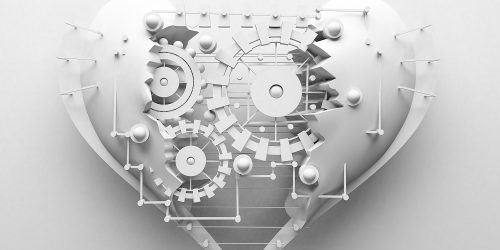
Your heart is a hollow muscular organ, about the size of your clenched fist. It pumps blood around the body, delivering oxygen to every organ and cell.
The heart lies in the middle of your chest, just behind the breast bone.
Structure of the heart
Inside the heart there are four chambers:
- two smaller chambers at the top (the right and left atria): these receive blood coming into the heart
- two larger chambers at the bottom (the right and left ventricles): these pump blood out of the heart
The wall between the right and left sides is the septum.
How blood flows through the heart
A network of blood vessels carry blood around the body. Arteries transport oxygen-rich blood to all parts of the body, and veins return oxygen-poor blood to the lungs. At the centre of this process is the heart, which acts as a pump.
This is the process by which the heart continuously pumps blood through the body:
- De-oxygenated blood that has circulated through the body is pumped into the right atrium.
- The blood then passes through the tricuspid valve into the right ventricle.
- The right ventricle pumps the blood through the pulmonary valve to the lungs, to receive a fresh supply of oxygen.
- Oxygen-rich blood then returns to the heart via the left atrium.
- It passes through the mitral valve and into the left ventricle.
- The left ventricle pumps the blood through the aortic valve into the aorta, which distributes blood to arteries throughout the body.
The coronary arteries
The coronary arteries branch off the aorta. They bring oxygen-rich blood to the heart muscle, which contracts about 70 times per minute to pump blood out to the body. If a coronary artery becomes blocked, blood will not flow to the muscle of the heart. This is what we call a heart attack.
The electrical system: a natural pacemaker
To achieve its regular pumping action the heart has a specialised area that acts as a pacemaker. This is the sino-atrial (SA) node, which lies in the right atrium (one of the upper chambers).
Through a two-part sequence, the heart maintains a rhythmic contraction. The SA node puts out an electrical signal or impulse that is carried through the atria to the atrioventricular node. The signal then passes through the ventricles (lower chambers).
These electrical impulses cause the heart muscle to contract in a regular rhythm.
Varied pulse rate
The heart beats at a rate of about 60–80 beats per minute at rest. But this rate does vary, depending on your level of activity.
During exercise it will increase, to supply more blood to the muscles and other parts of the body. To cope with this change of demand, the pacemaker (SA node) automatically speeds up. This increases the heart’s pumping rate, and more blood is delivered to the body.
To learn some simple steps to have a healthy heart click here.
